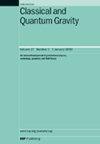双黑洞模拟中垃圾辐射结束时间的自动测定
IF 3.6
3区 物理与天体物理
Q2 ASTRONOMY & ASTROPHYSICS
引用次数: 0
摘要
当对爱因斯坦的双黑洞演化方程进行数值求解时,初始数据中的物理缺陷表现为瞬态高频“垃圾辐射”脉冲。在使用波形之前,必须去除这种非物理信号。数值模拟效率的提高现在允许生成包含数千种波形的波形目录。因此,需要一种自动识别垃圾辐射的程序。为此,我们提出了一种基于Hilbert-Huang变换的经验模态分解(EMD)的新算法。这种方法使我们能够隔离和测量在被测量的黑洞不可约质量中存在的高频振荡。这些振荡的衰减使我们能够估计出垃圾辐射可以忽略的时间。为了使这个过程更加精确,我们提出了三个不同的阈值标准,这些标准规定了垃圾辐射的贡献必须小到什么程度才能被认为是可以忽略不计的。我们将该算法应用于模拟极端时空目录中的3403 BBH模拟,以找到三个标准中阈值的合适值。我们发现,对于所研究的98.5%的模拟,这种方法产生了可靠的衰减时间估计,即何时考虑模拟物理。这证明了EMD在模拟双黑洞系统中作为一种自动隔离和表征垃圾辐射的合适工具的有效性。本文章由计算机程序翻译,如有差异,请以英文原文为准。
Automated determination of the end time of junk radiation in binary black hole simulations
When numerically solving Einstein’s equations for the evolution of binary black holes, physical imperfections in the initial data manifest as a transient, high-frequency pulse of ‘junk radiation.’ This unphysical signal must be removed before the waveform can be used. Improvements in the efficiency of numerical simulations now allow waveform catalogs containing thousands of waveforms to be produced. Thus, an automated procedure for identifying junk radiation is required. To this end, we present a new algorithm based on the empirical mode decomposition (EMD) from the Hilbert–Huang transform. This approach allows us to isolate and measure the high-frequency oscillations present in the measured irreducible masses of the black holes. The decay of these oscillations allows us to estimate the time from which the junk radiation can be ignored. To make this procedure more precise, we propose three distinct threshold criteria that specify how small the contribution of junk radiation has to be before it can be considered negligible. We apply this algorithm to 3403 BBH simulations from the Simulating eXtreme Spacetime catalog to find appropriate values for the thresholds in the three criteria. We find that this approach yields reliable decay time estimates, i.e. when to consider the simulation physical, for
> 98.5% of the simulations studied. This demonstrates the efficacy of the EMD as a suitable tool to automatically isolate and characterize junk radiation in the simulation of binary black hole systems.
求助全文
通过发布文献求助,成功后即可免费获取论文全文。
去求助
来源期刊

Classical and Quantum Gravity
物理-天文与天体物理
CiteScore
7.00
自引率
8.60%
发文量
301
审稿时长
2-4 weeks
期刊介绍:
Classical and Quantum Gravity is an established journal for physicists, mathematicians and cosmologists in the fields of gravitation and the theory of spacetime. The journal is now the acknowledged world leader in classical relativity and all areas of quantum gravity.
 求助内容:
求助内容: 应助结果提醒方式:
应助结果提醒方式:


